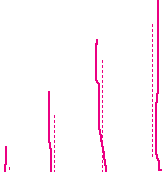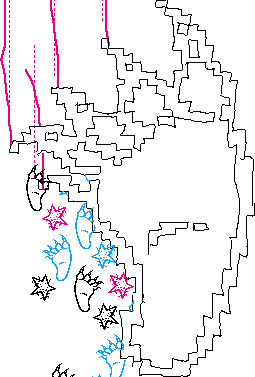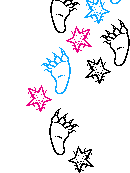| (1) GENERATION FLASH (2) FAQ (3) UTOPIA IN SOFWARE (4) THE UNBEARABLE LIGHTNESS OF FLASH (5) ART, MEDIA AND SOFTWARE ART (6) POSTSCRIPT LEV MANOVICH, 2002 (7) WEBSITES, THE ART OF OUR TIMES MILTOS MANETAS , 2002 (8) FLASH IS POPTECH PETER LUNENFELD, 2001
Generation Flash by
Lev Manovich This essay that consists from a number of self-contained segments looks at the phenomenon of Flash graphics on the Web that attracted a lot of creative energy in the last few years. More than just a result of a particular software / hardware situation (low bandwidth leading to the use of vector graphics), Flash aesthetics exemplifies cultural sensibility of a new generation.[1] This generation does not care if their work is called art or design. This generation is no longer interested in the "media critique" which preoccupied media artists of the last two decades; instead it is engaged in software critique. This generation writes its own software code to create their own cultural systems, instead of using samples of commercial media.[2] The result is the new modernism of data visualizations, vector nets, pixel-thin grids and arrows: Bauhaus design in the service of information design. Instead the Baroque assault of commercial media, Flash generation serves us the modernist aesthetics and rationality of software. Information design is used as tool to make sense of reality while programming becomes a tool of empowerment[3]
Turntable
and Flash Remixing
[Turntable is a web-based software that allows the user to mix in real-time different Flash animations, in addition manipulating color palette, size of individual animations and other parameters. For www.whitneybiennial.com, the participating artists were asked to submit short Flash animations that were exhibited on the site both separately and as part of Turntable remixes. Some remixes consisted from animations of the same artists while others used animations by different artists.]
It became a cliché to announce that “we live in remix culture.” Yes, we do. But is it possible to go beyond this simple statement of fact? For instances, can we distinguish between different kinds of ermine aesthetics? What is the relationship between our remixes made with electronic and computer tools and such earlier forms as collage and montage? What are the similarities and differences between audio remixes and visual remixes? Think loop. The basic building block of an electronic sound track, the loop also conquered surprisingly strong position in contemporary visual culture. Left to their own devices, Flash animations, QuickTime movies, the characters in computer games loop endlessly - until the human user intervenes by clicking. As I have shown elsewhere, all nineteenth century pre-cinematic visual devices also relied on loops. Throughout the nineteenth century, these loops kept getting longer and longer - eventually turning into a feature narrative…Today, we witness the opposite movement – artists sampling short segments of feature films or TV shows, arranging them as loops, and exhibiting these loops as “video installations.” The loop thus becomes the new default method to “critique” media culture, replacing a still photograph of postmodern critique of the 1980s. At the same time, it also replaces the still photograph as the new index of the real: since everybody knows that a still photography can be digitally manipulated, a short moving sequence arranged in a loop becomes a better way to represent reality - for the time being.) Think Internet. What was referred in postmodern times as quoting, appropriation, and pastiche no longer needs any special name. Now this is simply the basic logic of cultural production: download images, code, shapes, scripts, etc.; modify them, and then paste the new works online - send them into circulation. (Note: with Internet, the always-existing loop of cultural production runs much faster: a new trend or style may spread overnight like a plague.) When I ask my students to create their own images by making photographs or by shooting video, they have a revelation: images do not have to come from Internet! Shall I also reveal to them that images do not have to come from a technological device that record reality – that instead they can be drawn or painted? Think image. Compare it to sound. It seems possible to layer many many many sounds and tracks together while maintaining legibility. The result just keep getting more complex, more interesting. Vision seems to be working differently. Of course commercial images we see everyday on TV and in cinema are often made from layers as well, sometimes as many as thousands – but these layers work together to create a single illusionistic (or super-illusionistic) space. In other words, they are not being heard as separate sounds. When we start mixing arbitrary images together, we quickly destroy any meaning. (If you need proof, just go and play with the classic The Digital Landfill[4]) How many separate image tracks can be mixed together before the composite becomes nothing but noise? Six seems to be a good number – which is exactly the number of image tracks one can load onto Turntable. Think sample versus the whole work. If we are indeed living in a remix culture does it still make sense to create whole works – if these works will be taken apart and turned into samples by others anyway? Indeed, why painstakingly adjust separate tracks of Director movie or After Effects composition getting it just right if the “public” will “open source” them into their individual tracks for their own use using some free software? Of course, the answer is yes: we still need art. We still want to say something about the world and our lives in it; we still need our own “mirror standing in the middle of a dirty road,” as Stendahl called art in the nineteenth century. Yet we also need to accept that for others our work will be just a set of samples, or maybe just one sample. Turntable is the visual software that makes this new aesthetic condition painfully obvious. It invites us to play with the dialectic of the sample and the composite, of our own works and the works of others. Welcome to visual remixing Flash style. Think Turntable.
-------------------------------------------------------------------------------- [1] This article is about “Flash Generation” and not about the Web sites made with Flash software. Many of the sites which inspired me to think of “Flash aesthetics” are not necessarily made with Flash; they use Shockwave, DHTML, Quicktime and other Web multimedia formats. Thus the qualities I describe below as specific to “Flash aesthetics” are not unique to Flash sites. [2] For instance, the work of Lisa Jevbratt, John Simon, and Golan Levin. [3] “Generation Flash” incorporates revised versions of the texts commissioned for www.whitneybiennial.com and http://www.biennale.net. Both exhibitions were organized by Miltos Manetas / Electronic Orphanage. “On UTOPIA” was commissioned by Futurefarmers. [4] See http://www.potatoland.org/landfill/ [5] After
GUI-based applications such as Hypercard, Director, Photoshop and
others became commonplace, many computer artists continued to do
their own programming: writing custom code to control an interactive
installation, programming in LINGO an interactive multimedia work,
etc. This was not refereed to as software art; it was taken for
granted that even in the age of GUI-based applications a really
serious artistic engagement with computers requires getting ones
hands dirty in code. |
![]()
 |
 |
 |